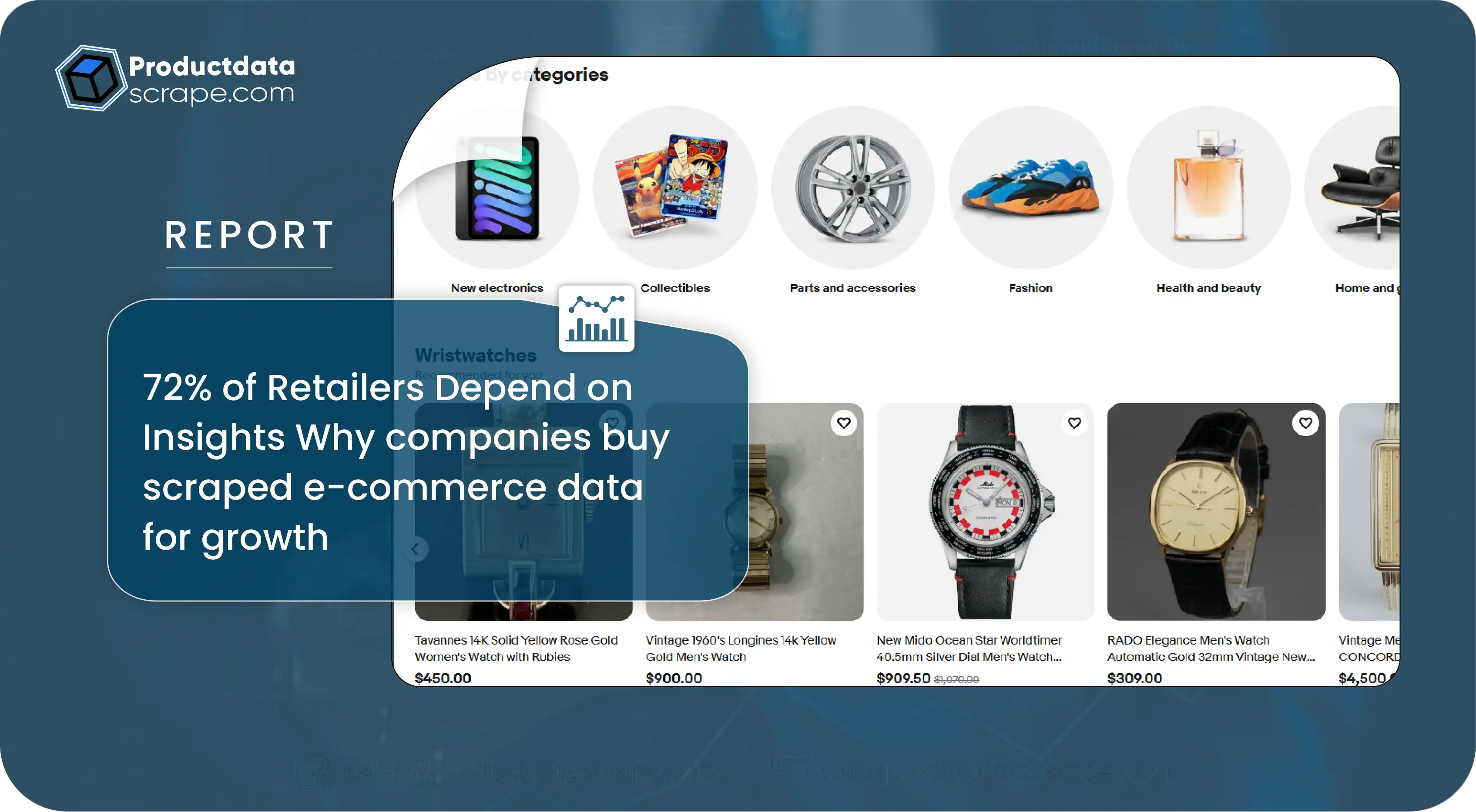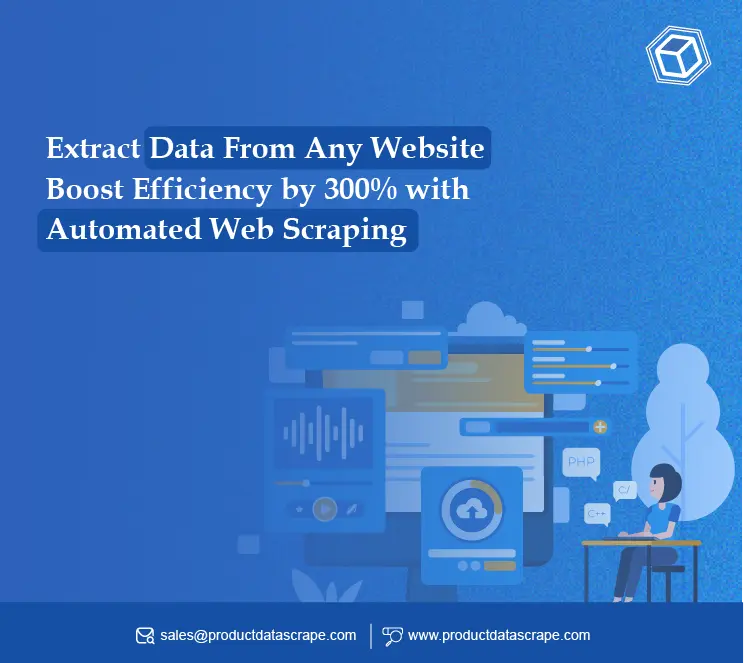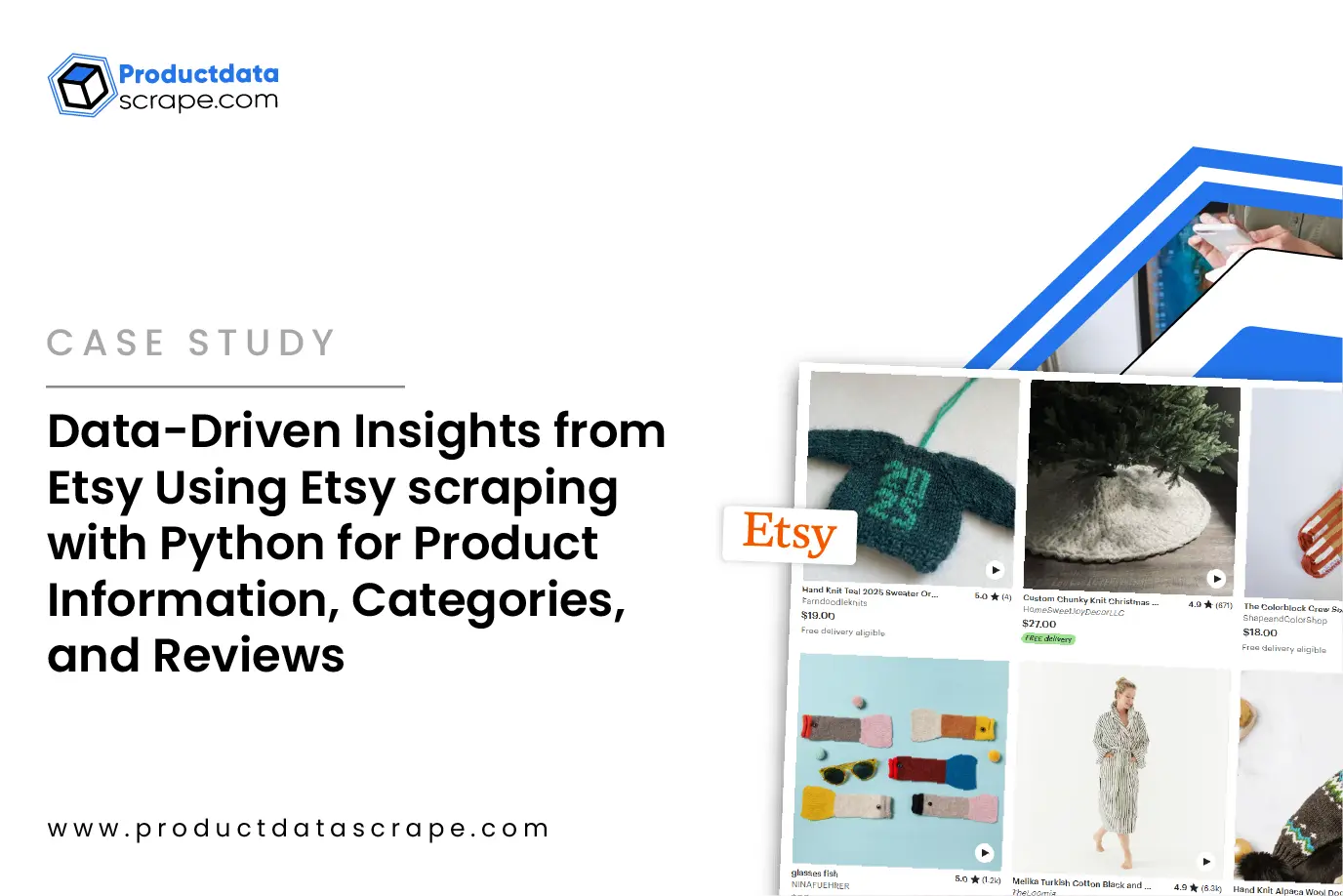
Introduction
The digital commerce industry is undergoing a rapid transformation, with data-driven decision-making becoming the cornerstone of retail growth. A recent survey highlights that nearly 72% of retailers now depend on insights extracted from web data to optimize pricing, forecast demand, and enhance customer experience. This makes understanding why companies buy scraped e-commerce data more important than ever.
Businesses today cannot rely solely on internal sales metrics. To stay ahead, they require competitive benchmarks, pricing visibility, consumer behavior analytics, and real-time inventory tracking. This is where data scraping proves invaluable. From analyzing thousands of SKUs across marketplaces to identifying promotional trends, scraped e-commerce data for market insights enables brands to build stronger strategies.
Retailers also seek custom scraping services that deliver tailored datasets according to their niche, whether in electronics, fashion, or groceries. As more brands move toward data-first models, the emphasis on acquiring accurate, scalable, and structured data grows.
This report explores the best sources to buy e-commerce product data, examines how companies purchase commerce product price scraping data, and highlights the business impact of scraping across 2020–2025. By the end, readers will fully understand why companies buy scraped e-commerce data and how it fuels measurable growth.
Best Sources to Buy E-Commerce Product Data
The foundation of actionable insights lies in sourcing reliable datasets. Over 2020–2025, research indicates that global e-commerce scraping demand has grown at a CAGR of 14%, with the U.S., Europe, and Asia-Pacific leading. Retailers and researchers alike prioritize best sources to buy e-commerce product data, as these sources influence accuracy and comprehensiveness.
Reliable sources typically include:
- Marketplaces like Amazon, Walmart, and eBay.
- Retail brand websites across fashion, electronics, and FMCG.
- Regional marketplaces such as Flipkart (India) or MercadoLibre (Latin America).
- Web scraping e-commerce websites using automation for structured data extraction.
For example, between 2020 and 2025, the average number of retailers scraping from at least five competitors has risen from 28% to 63%, showing the shift toward multichannel insights.
| Year |
% of Retailers Using Scraped Data |
Average Competitors Tracked |
| 2020 |
28% |
2 |
| 2021 |
34% |
3 |
| 2022 |
46% |
4 |
| 2023 |
55% |
5 |
| 2024 |
60% |
5–6 |
| 2025 |
72% |
6+ |
Companies that invest in quality data sources consistently outperform those relying on siloed analytics. This explains why companies buy scraped e-commerce data, as validated datasets form the baseline of competitive strategy.
Purchase Commerce Product Price Scraping Data
Pricing is the single largest factor influencing consumer purchase decisions. According to Statista, 74% of online shoppers in 2023 compared prices across at least three platforms before purchasing. This makes the ability to purchase commerce product price scraping data crucial for retailers.
By 2025, companies that actively monitor competitive pricing report 45% faster revenue growth than those who don’t. Price scraping captures discounts, promotions, and regional variations. For instance, in 2024 alone, the number of retailers deploying buy competitor price intelligence datasets rose by 38%.
| Year |
% of Retailers Using Scraped Data |
Average Competitors Tracked |
| 2020 |
28% |
2 |
| 2021 |
34% |
3 |
| 2022 |
46% |
4 |
| 2023 |
55% |
5 |
| 2024 |
60% |
5–6 |
| 2025 |
72% |
6+ |
This data confirms that why companies buy scraped e-commerce data is directly tied to revenue acceleration. Businesses can now optimize pricing dynamically, reduce cart abandonment, and tailor promotions to outperform rivals.
Extract Consumer & Product Data from Online Stores
Consumer behavior analytics has grown into a billion-dollar domain. Retailers today demand the ability to extract consumer & product data from online stores to align with shifting shopping preferences.
For example, over 2020–2025, consumer preference data usage rose from 40% to 71%, driven by personalization initiatives. Data captured includes product searches, ratings, purchase frequency, and seasonal demand.
Retailers use this information to refine McDonald’s restaurant location strategy in the U.S. (example analogy for expansion planning). Similarly, custom eCommerce dataset scraping solutions empower businesses to build datasets unique to their brand positioning.
| Year |
Retailers Using Consumer Behavior Data |
Personalization ROI |
| 2020 |
40% |
+10% |
| 2021 |
45% |
+14% |
| 2022 |
52% |
+20% |
| 2023 |
61% |
+28% |
| 2024 |
67% |
+35% |
| 2025 |
71% |
+41% |
Here, why companies buy scraped e-commerce data becomes evident: actionable consumer-product datasets not only forecast demand but also refine targeting, boosting conversion rates across campaigns.
Buy Competitor Price Intelligence Datasets
Competitive intelligence is a driving force in today’s retail strategies. Businesses increasingly buy competitor price intelligence datasets to benchmark themselves against market leaders.
From 2020–2025, the global competitor data market grew by 21% CAGR, highlighting the growing reliance on external intelligence. Key benefits include benchmarking SKU-level prices, regional trends, and promotional campaigns.
Scraped e-commerce data for market insights reveals not just current market standing, but also predictive pricing models that retailers use to forecast competitor strategies. For example, in 2024, 58% of retailers deployed predictive AI on competitor datasets.
| Year |
Retailers Using Competitor Datasets |
Forecast Accuracy Improvement |
| 2020 |
24% |
+10% |
| 2021 |
29% |
+13% |
| 2022 |
37% |
+18% |
| 2023 |
46% |
+25% |
| 2024 |
58% |
+32% |
| 2025 |
65% |
+40% |
This validates why acquiring buy custom dataset solution is now a mainstream practice, empowering retailers to respond faster and outperform in competitive pricing battles.
Scraped E-Commerce Data for Market Insights
The future of retail lies in insights, not just raw numbers. Scraped e-commerce data for market insights delivers deep intelligence on consumer trends, market saturation, and growth opportunities.
Between 2020 and 2025, companies using market insight scraping solutions grew 1.7x faster than those without. Advanced restaurant location data scraping and retail equivalents show that geographic expansion, SKU optimization, and new product introductions depend heavily on structured insights.
Custom scraping services ensure that businesses extract only the data relevant to their goals, whether focused on seasonal campaigns or long-term category expansion.
| Year |
Retailers Using Market Insights |
Business Growth Multiplier |
| 2020 |
32% |
1.1x |
| 2021 |
39% |
1.2x |
| 2022 |
47% |
1.3x |
| 2023 |
55% |
1.5x |
| 2024 |
61% |
1.6x |
| 2025 |
70% |
1.7x |
Thus, why companies buy e-commerce datasets is driven by their need for foresight in a saturated and fast-moving industry.
Custom eCommerce Dataset Scraping for Expansion
While generalized datasets help, tailored solutions are often more impactful. Custom eCommerce dataset scraping allows retailers to design data pipelines specific to their industry, region, and growth objectives.
For example, from 2020–2025, custom dataset adoption increased from 21% to 64% across global retailers. By 2025, businesses leveraging tailored scraping reported 33% higher ROI compared to those using generic datasets.
Buy custom dataset solution models allow retailers to combine structured web scraping with internal data warehouses for hybrid insights. Meanwhile, Walmart Grocery Scraping API-style integrations prove how scalable custom solutions can be.
| Year |
Custom Dataset Adoption |
ROI Improvement |
| 2020 |
21% |
+8% |
| 2021 |
28% |
+12% |
| 2022 |
37% |
+18% |
| 2023 |
46% |
+22% |
| 2024 |
55% |
+28% |
| 2025 |
64% |
+33% |
This makes custom eCommerce dataset scraping the next frontier in why companies buy scraped e-commerce data, ensuring a strategic advantage in fast-changing markets.
Product Data Scrape stands as a leader in delivering high-quality, structured datasets for e-commerce businesses. With expertise in web scraping e-commerce websites, the platform ensures 100% accuracy, scale, and compliance. Clients benefit from tailored buy custom dataset solution offerings, integrating seamlessly with CRMs, ERPs, and analytics dashboards. The platform’s reputation lies in delivering timely, large-scale datasets covering pricing, consumer behavior, and competitor intelligence.
Conclusion
The digital retail revolution demands more than intuition—it demands intelligence. As data-driven strategies dominate the market, why companies buy scraped e-commerce data has become clear: growth, competitiveness, and agility.
From understanding pricing dynamics to tracking consumer preferences and forecasting competitor moves, scraped datasets empower businesses to scale rapidly. Between 2020 and 2025, adoption grew from 28% to 72%, signaling that data-first retailers are winning the race.
Product Data Scrape supports this transition with precise, scalable, and customized solutions. Whether you’re seeking product pricing, consumer trends, or competitor monitoring, the platform ensures seamless access to mission-critical insights.
Ready to turn data into your competitive edge? Partner with Product Data Scrape today and unlock the future of intelligent retail growth!







